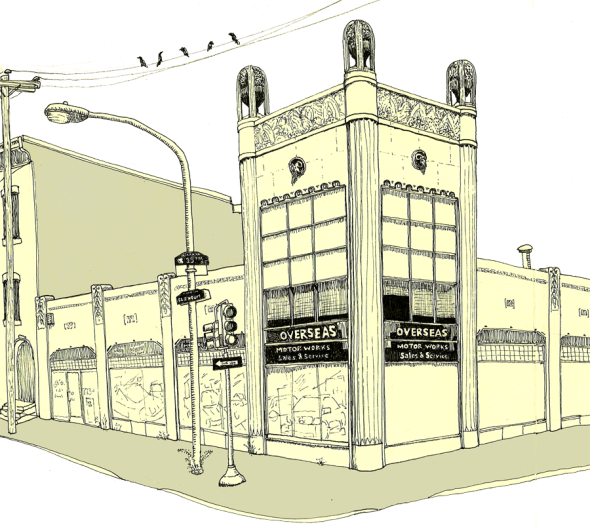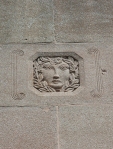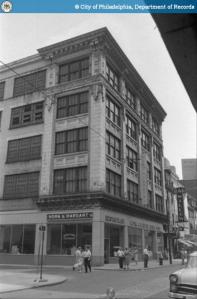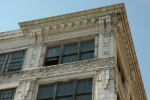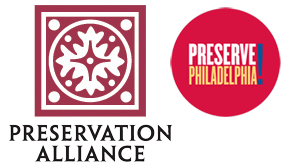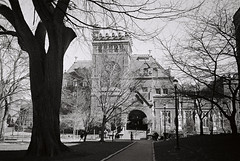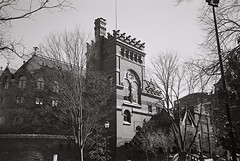Tube Tuesday: Philadelphia Plans For “New” City
Another gem from the dustbin, this is classic footage of the 1947 Better Philadelphia Exhibition and its famous flipping model designed by Louis Kahn, Edmund Bacon, and Oskar Stonorov. The narration on this newsreel is sadly lost, so we may never know what’s going on with the guy in the undershirt and sandals. Read more about the exhibition here. (This is just one of many interesting Philly clips available at http://www.criticalpast.com).
Unlisted: Overseas Motor Works
Written and drawn by Ben Leech
Unlisted is a series of portraits highlighting Philadelphia buildings not yet listed on the Philadelphia Register of Historic Places. To learn how to protect a building by nominating it to the Register, click here.
Address: 1501 Fairmount Avenue
Architect: Unknown
Built: Unknown (c.1930s)
What ancient art deco civilization left this Babylonian-looking castle-cum-garage on the corner of 15th and Fairmount? Carlos, who has operated the Overseas Motor Works in the building for the last thirty years, has no idea. “It was vacant when we moved in,” he remembers. “An old man used to pass by here when we first started, said he remembered the place divided up into little stalls, like a market. Places selling parts, appliances, that kind of thing. But I have no idea who built it or why. Not much history here that I know of, Ben Franklin was never here, you know? I did have a guy looked just like him as a customer for many years, though.”
It is an enigmatic building, to say the least. Adorned with ram’s heads, maidens’ faces, doves in a dovecote, flower-filled urns, and palm fronds aplenty, the walls are made from pink-hued concrete blocks. The same material was used in another art-deco building a few doors down Fairmount, built in 1932 as a showroom and warehouse for the National Casket Company. With the vaguely funerary aura of its urn-topped tower, its tempting to guess a connection to the casket building, but I couldn’t prove it. Can anyone help solve this riddle?
Tube Tuesday: Vintage Philly
Pure vintage boosterism. Worth it for the street scenes alone– skip up to 2:30 for some amazing neon, “flashing in the night of complacency and ignorance!”
Unlisted: Sound of Market
Written and drawn by Ben Leech
Unlisted is a series of portraits highlighting Philadelphia buildings not yet listed on the Philadelphia Register of Historic Places. To learn how to protect a building by nominating it to the Register, click here.
Address: 15-21 S. 11th Street
Architect: Sauer & Hahn? William Steele & Sons?
Built: 1912
Standing on the corner of Ludlow and 11th Street, in the heart on Center City’s low-rent district, you’d be forgiven for assuming that the nameless building at 15-21 S. 11th Street was abandoned. Unless, of course, you were one of the city’s lonely souls who frequent the Sound of Market, aka JazSound, a two-floor music store that occupies most of this disheveled but perseverant jewel of a building. You enter through a ground-floor storefront selling cut-rate perfume, luggage, incense and lottery tickets, head for a stairwell in the back, and ascend to find one of the best record selections in town spirited away behind the boarded-up windows and weathered shell of a once-resplendent commercial block. A forgotten CD emporium in the age of iTunes, it is a fitting (if also fleeting) use for a building that could very well be the most underappreciated piece of architecture in Center City.
Its pedigree is surprisingly unknown. In a twisted echo of its current incarnation, the building replaced the Eleventh Street Opera House, a nineteenth-century church-cum-vaudeville theater with the dubious distinction of staging the last black-face show in America (Dumont’s Minstrels) before it finally shuttered in 1911. Built in 1912, the new building’s original tenants included a Horn & Hardart Automat and a Gueting’s Shoe store. It was possibly designed by Sauer & Hahn, since the well-known commercial and industrial architects are listed as doing work for both Gueting’s and Horn & Hardart at this address in 1912. However, the owner of the building was Joseph M. Steele, whose William Steele & Sons empire was responsible for the design and construction of numerous other office buildings in the teens and twenties, including the iconic terra cotta Market Street National Bank and the Terminal Commerce Building. But regardless of whether the design was by Sauer & Hahn, Steele & Sons, or a collaboration between the two, the building stands on its own as good architecture.
Perhaps best described as “beaux-arts-and-crafts,” its rich polychrome palate and geometric details represent an important transitional era in architecture when terra cotta started to outgrow its role as an imitative stand-in for traditional carved stone. Classical ornament evolved into colorful, abstract geometries. The rich hues of ceramic glazes were celebrated. The structural grid was emphasized. In many other cities (Chicago, Pittsburgh and St. Louis spring to mind), this moment in architecture produced a veritable cornucopia of architectural classics, paving the way for Art Deco. In Philadelphia, however, this is one of our only examples.
Like Goethe said, architecture is music frozen in time, but a music store can only stay frozen in time for so long. The building is in surprisingly good shape, with most of its original wood sash and steel casement windows in place and its distinctive cornice intact. But for how long is anybody’s guess. If and when the Sound of Market goes the way of Tower, Virgin, and countless other dinosaurs of the CD era, this once-grand automat will be just another semi-abandoned building in a shrinking low-rent patch of Center City. Why not recognize it as a landmark while we still have the chance?
Tube Tuesday: The Eraserhood
A portrait of “Eraserhood,” the Callowhill neighborhood that inspired David Lynch’s Eraserhead. A portion of this neighborhood is in the process of being added to the National Register of Historic Places (but not because Lynch lived here):
http://planphilly.com/gritty-callowhill-recognized-national-historic-district
Tube Tuesday: Greenbelt Knoll
Greenbelt Knoll was designated a Philadelphia Historic District in 2006, and in 2007 the residents of the neighborhood received the Preservation Alliance’s Community Action Award. This short documentary was produced for the Scribe Video Center’s Precious Places series.
For more on Greenbelt Knoll, click here.

